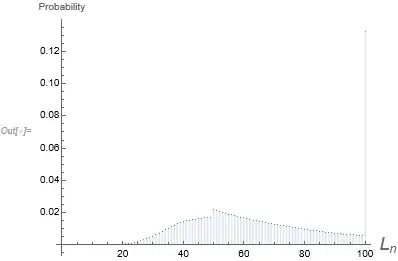Using what's in The Longest Runs of Heads one can define the probability that the random variable representing the longest run of heads ($L_n$) in $n$ independent Bernoulli trials with probability $p$ being at least $m$ (with $0 < m \leq n$) is given by
$$\text{Pr}(L_n \geq m)=\sum_{j=1}^{\lfloor n/m\rfloor} (-1)^{j+1}(p+(1-p)(n-j m+1)/j)\binom{n-jm}{j-1}p^{jm}(1-p)^{j-1}$$
Using Mathematica one can define that probability and $\text{Pr}(L_n = m)$ as follows:
pr[n_, m_, p_] := If[m == 0, 1, If[n == m, p^n,
Sum[(-1)^(j + 1) (p + (n - j m + 1) (1 - p)/j) Binomial[n - j m, j - 1]*
p^(j m) (1 - p)^(j - 1), {j, 1, Floor[n/m]}]]]
pmf[n_, m_, p_] := If[m == n, p^n, pr[n, m, p] - pr[n, m + 1, p]]
For $n=100$ and $m=17$,
$\text{Pr}(L_{100}\geq17)= \frac{807780445313798916450095934117445355240816809130204895312189263256395811340410276473406861611831413649096156560908303528096043592424959181087412002228997}{807793566946316088741610050849573099185363389551639556884765625000000000000000000000000000000000000000000000000000000000000000000000000000000000000000000}$.
or approximately 0.99998375620572620341.
A plot of the pmf of $L_n$ with $n=100$ and $p=0.98$ follows:
DiscretePlot[pmf[100, m, 98/100], {m, 0, 100}, PlotRange -> All, AspectRatio -> 3/4,
AxesLabel -> {Style[Subscript[L, n], Italic, 18], "Probability"}]

Yes, not a typical-looking probability mass function.

